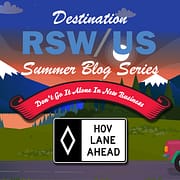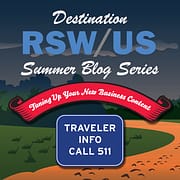This article, End of Summer. Start of a More Effective Agency New Business Program, is the final post of our Destination RSW Summer Blog Series, designed to help you navigate the hazards encountered on the road to new business.
This post is from RSW Owner/President, Mark Sneider.
Hard to believe it is the end of the Summer and our Summer Campaign is coming to an end.
I hope you enjoyed all the great perspective from our outstanding team of New Business Directors, List Development Managers, and Marketing Communication Managers at RSW/US.
And hope you liked the “campy” map mailer we sent you.
Those marketers on the map really are marketers we helped our agency clients win.
Didn’t get one? Let lee@rswus.com know.
Like all of the other content we push out weekly, our goal with the Summer Campaign was to provide you with recommendations and ideas that can help you build a better new business program for your agency without having to hire an outsourced agency new business firm like ours.
In addition to providing you with an on-going stream of good and thoughtful content, one other way we help agencies like yours is to work one-on-one with your firm.
I just completed another consulting assignment for a small marketing agency in Louisville to do just that: help them put a plan in place to accelerate their own new business efforts.
Only recently did I start doing this type of work.
I figured 16 years of managing outsourced agency new business programs and helping agencies find and win new business gives me a bit of permission to seek out firms that are interested in helping themselves by seeking outside perspective and counsel.
Like many of my assignments, my charge with this firm was to try and help them organize an effective inside new business development program.
While they were very pleased with the recommendations and ideas I presented to them, the challenge they now face is executing against the plan.
Fortunately for them, I’ll keep myself present to help them in the coming months to guide their efforts.
And fortunately for them, they seem ready to execute against the plan.
This agency is like a lot of our agency clients at RSW/US when we first walk into an outsourced relationship with them.
They have little-to-no content or collateral.
They have a very limited outbound effort because most of their new business comes in via referrals and networking.
They are more reactive in how they deal with RFPs and proposal requests.
And they spend too much time talking about themselves and not enough time focusing on their prospects.
Unlike many other firms, this Louisville firm had at least laid down a foundation of thinking relative to how they’d like to build an internal program and the specific things they’d like to implement.
While there were many good ideas baked into the plan they created, there were two glaring issues that were sure to get in their way of success:
-
The plan was unattainable. Too many tactics. Too unrealistic given their resources.
You can’t go from doing nothing to doing everything overnight, or even over the course of a year.
So, I recommended they focus on the basics…the elements that would allow them to maintain some consistency of outreach and consistency of creating good content and collateral to attract the prospects they’re interested in meeting with.
Trying to do it all would become discouraging because nothing would get done well.
-
They were going to manage new business via a team approach, without a single individual leading the charge.
You can’t manage new business by committee.
I’ve seen it done before and it doesn’t end well.
It slows things down and makes it difficult to gain any real positive momentum in a new business program.
Just like most agencies, this agency needed one key individual that could organize, orchestrate, and lead the effort.
Others could participate, but their involvement needed to be kept to a minimum.
Fortunately, this agency had one individual that I identified that (I believed) could fulfill that role.
I’m confident this agency will meet with success.
They are seemingly committed to bettering their program and share a passion for building a well-oiled new business machine.
So hopefully things will end well for this agency, just like this summer is ending well for us and hopefully for you.
It’s time to take stock of your new business plan and start thinking about what you should be doing to ready yourself most effectively for 2022.
Here’s to your success!
Thanks for following our Summer Campaign: The Road to New Business over the past couple of months!
You’ll see it resurface in February when we host another Virtual Conference. More to come on that later.
And finally, if you need any help, feel free to give me a call (513-293-6785), or drop me a line (mark@rswus.com).
Happy to connect.
Have a great Q4!










